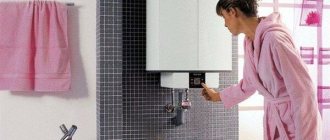When planning to install a geyser in the bathroom, you must take into account a number of regulations and adhere to the regulations. Operation of the equipment must be safe, as provided for in the installation rules.
In some cases, the optimal place to place the speaker is the bathroom.
Possibility of installing gas equipment in the bathroom
Gas units are subject to strict safety standards, which are regulated by law. They indicate all the requirements for installation and use of the system with minimal risk to health.
It is most rational to install the boiler in a specially designated room, but not all owners of houses or apartments have this opportunity, because... The amount of free space in the home is limited.
Previously, the equipment was placed in the kitchen, but modern trends in interior design consider this installation option to be unaesthetic.
During the Soviet Union, it was practiced to install a boiler in the bathroom of Khrushchev and Stalin buildings. This made it possible to change the heating temperature and engage in bath procedures without damaging the interior of the kitchen.
After cases of carbon monoxide poisoning, the installation of boilers in bathrooms was prohibited. In modern regulations there is no such restriction, but at the same time strict requirements are specified for buildings where gas systems are installed.
Why was this previously banned?
Until the mid-80s. last century there were 2 requirements for the installation of gas equipment:
- The presence of a chimney near the column.
- Connecting the system to the riser.
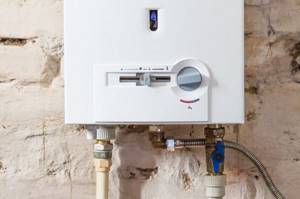
But due to the presence of impurities in household gas, operation of the system was accompanied by the accumulation of soot and burning. In addition, the design of the heaters was quite primitive, and there were no automatic soot removal systems, which made the equipment potentially dangerous.
Against the backdrop of increasing cases of explosions of units and carbon monoxide poisoning, the authorities have banned the use of boiler installation schemes in the bathroom.
By the end of the 20th century. regulations for the installation of household appliances have been radically revised. Therefore, today the possibility of placing a speaker in a bathroom depends on the size of the room.
How to bypass the ban now
There are several ways to circumvent the ban on installing a boiler in the bathroom. At the design stage of the building, some owners specify a spacious kitchen in which all the heating equipment is located, and after the apartment is put into operation, they install plasterboard partitions.
Some consumers indicate in the project that a boiler room is located on the site of the bathroom, but upon completion of construction they install the bathtub back.
There is also a legal way to circumvent the prohibitions, which is as follows:
- The head of the Gas Service must submit an application regarding the possibility of connecting a boiler or water heater in the bathroom.
- The document should indicate the reasons that allow the installation of equipment.
- If a representative of the organization refuses to give permission to carry out work, you can go to court, providing all the arguments.
Documentation
In order to install a gas water heater in an apartment or private house, you will need the following documents:
- Technical passport of the purchased dispenser or indication of the model in case of subsequent purchase of the unit.
- A report on the technical condition of the hood or chimney, drawn up by the exhaust and chimney duct inspection service.
- Project for placing new water heating equipment and connecting it to the gas and water mains in accordance with the technical specifications.
- An application submitted by the owner for the reconstruction of a premises with a water pump must additionally provide proof of ownership and a technical passport for the apartment.
- An application for installation work sent to the gas supply organization (Gorgaz) with a project attached.
The company engaged in the maintenance of the purchased gas water heater or specialists from the gas supply organization are required to perform the following actions when installing the equipment:
- Make a connection into the gas pipeline with the installation of metering devices and a shut-off valve.
- Hang the column with the flammable surface of the wall lined with insulating materials (tin in combination with asbestos or basalt sheets), connect a flexible gas supply to the unit.
- Connect the column to the chimney or exhaust system using a pipeline.
- Connect flexible hoses from the unit to the cold water main and hot water supply pipes.
- Upon completion of the work, the Gorgaz specialist must set up and start the dispenser, seal the gas meter and draw up a report on putting the unit into operation.
The cost of installing a gas water heater at home by private specialists will cost about 3,000 rubles; gas supply companies, depending on the region, carry out the connection at their own prices.

Rice. 10 Recommended spacing and placement of insulation
Requirements for premises according to SNiP
The installation of gas equipment in the bathroom is regulated by SNiP. Document 2.04.08-87 mentions a direct ban on the installation of heating devices in such buildings.
Studying the latest edition of the act SP 402.1325800.2018, you can see clause 5.6, which states that it is prohibited to install gas-using devices in bathrooms and bathrooms.

To protect the system from moisture, copper pipes are used.
Regardless of the features of the model, the equipment includes metal parts that are subject to oxidation when interacting with moisture. To protect the system from such phenomena, pipes made of copper or metal-polymer materials are used. If the rules are not followed, the unit will quickly wear out, increasing the likelihood of an explosion.
For speakers
Gas water heaters are potentially dangerous devices. Therefore, the room where the boiler will be installed must meet the strict fire safety requirements specified in SNiP and SP, as well as in the official recommendations of equipment suppliers.
The main regulatory restrictions include the following:
- The ceiling height is from 2 m.
- The room has a supply and exhaust or natural ventilation system, which ensures effective air replacement.
- The total area of the room is at least 12 square meters. m.
- The room has a window or window that opens.
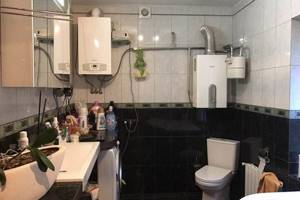
Any non-residential buildings that meet the listed requirements are suitable for the boiler room. Technical restrictions vary based on regional specifications. Therefore, before installing the column, you should familiarize yourself with the regulations in force in your locality.
The regulations indicate that the equipment should be fixed at a distance of at least 25-30 cm from the ceiling. A distance of 80-120 cm is maintained between the floor covering and the body.
For gas boilers
Domestic gas boilers can be installed in those premises that meet the following requirements:
- Area from 4 sq. m.
- Entrance door from 80 cm wide.
- Good lighting (0.3 sq.m of glazing per 10 cubic meters of space).
- Ceilings from 2.5 m high.
- Availability of a ground loop.
- Access to cold water pipes.
- The presence of a chimney, the cross-section of which corresponds to the performance of gas-using equipment.

m. In addition, the surface of the walls in the boiler room must be leveled and plastered.
Decorating a hot water column
The heating element must not be placed within the walls of the room. To hide it, they use finishing material. The most common base is drywall. A cabinet-shaped structure is made from it.
Requirements for a niche for a hot water column:
- The volume of the structure must be significantly larger than the equipment itself
- Free access to the device at any time. To do this, the box is equipped with a door. Hiding a column in an integral structure is unacceptable
- Good ventilation of the water heater. The finished niche must be provided with air flow even when closed
In addition to drywall, decorative metal plates are used. They cover the exhaust pipe. This material is heat resistant. Perforated sheets or strips will help solve the problem with niche ventilation. The mix of materials looks good. For example, the sides of the box are made of plasterboard, and the door is made of slats placed one on top of the other. Ventilation conditions are met, the column is hidden.
Sanctions for violation of norms
In case of violation of the requirements for the installation of gas-using systems, penalties may be imposed, followed by shutdown of the fuel supply and other unpleasant consequences.
Equipment is checked once a year, so during the next scheduled inspection, gas service employees may issue a fine.
If the mandatory rules of the joint venture regarding gas supply are ignored, the violator faces being disconnected from the main pipeline within 40 days.
In addition, leading boiler manufacturers will remove the warranty on appliance servicing if they deviate from safety standards.
Comparative characteristics of water heating equipment
To understand which water heaters for the bathroom are the most optimal, you need to understand the principle of operation and know the main characteristics of each type of device.
Cumulative
Storage heaters for the bathroom operate on electricity and are capable of not only heating water to a temperature of 55-75 degrees, but also maintaining this temperature throughout the day. Water heating is carried out using a heating element, and the main advantages of such devices include economical energy consumption. This efficiency is due to the presence of good thermal insulation, due to which the water in the boiler is always warm.
The disadvantages include:
- Quite a long heating time.
- Relatively large dimensions.
However, for small families, you can use modern sink water heaters, which take up minimal space due to their small volume.
Owners of storage devices must remember that such equipment requires regular maintenance, which consists of cleaning heating elements from limescale and periodically replacing the magnesium anode, which prevents corrosion of the inside of the water heater.
Under-sink water heaters have a capacity of 10 to 15 liters and are used only for hand washing and washing. If you need a water heater for a shower stall, then you need to choose devices with a capacity of 50 liters or more. It should be borne in mind that the price of such units will significantly exceed the cost of devices with a capacity of 10-15 liters.
Storage water heaters can differ not only in volume, but also in the method of energy consumption. Thus, some units are capable of operating from several sources of electrical energy. Therefore, they are excellent for use in country houses, cottages, and dachas.
Depending on the needs and number of people in the family, water heaters for the bathroom are selected according to the following principle:
- 150-180 l - devices of this capacity are recommended for families of more than three people. The water consumption of such devices at a temperature of about 60˚C will be 98-110 liters.
- 10-20 l - such water heaters are installed under the kitchen sink (water consumption at a temperature of 60 ˚C is 8-16 l).
- 30-50 l - used for showering. Water consumption at a temperature of 60 ˚С - 16-27 l).
- 2-5 l - such a storage water heater is suitable only for a sink used for washing hands. Water consumption - 1-3 l.
Flow-through
The principle of operation of an instantaneous water heater is to instantly heat the water coming from the water supply. The device is equipped with a small chamber with a heating element that heats the liquid to a predetermined temperature. The water heater turns on immediately after opening the tap and turns off after the water supply stops.
Such water heaters are used both for the bathroom and for the kitchen. Their main advantages include:
- Compact sizes.
- Ability to regulate temperature.
- There is no need to equip the device with a chimney, as required, for example, by a gas water heater in the bathroom.
- Relatively low price - from 4 to 18 thousand rubles.
Mixer thermostats
A mixer-water heater with a thermostat is capable of automatically maintaining the desired water temperature, as well as its constant pressure. This device is equipped with two regulators, a temperature scale and a limiter that allows you to regulate the temperature.
The advantages of a water heater mixer are:
- Possibility to save water.
- Protection from getting burned by too hot a stream of water, or from troubles associated with a sudden release of an icy stream from the tap.
So, if the water supply stops, the mixer-water heater will instantly shut off the water, which will prevent you from getting scalded by hot water. This property of the device is especially useful in homes where small children live.
Main characteristics of geysers
Gas water heaters are characterized by fast water heating, small dimensions and ergonomics. In addition, they are equipped with various sensors and automatic systems that eliminate fuel leakage.

Gas water heaters are equipped with various sensors.
The power of water heaters varies from 15 to 30 kW, taking into account the area of the room.
What characteristics should the equipment have?
The equipment used must ensure safe and durable operation during the service life established by the manufacturer.
It is allowed to install only those units that exactly comply with regional regulations and are certified by the Gosgortekhnadzor of Russia.
Is it permissible to carry out hidden installation of gas equipment?
Each device is equipped with an independent gas pipeline with a shut-off valve, which is made of a metal pipe. Taking into account this feature, it is impossible to hide the structure through hidden installation.
At the points where the gas pipeline passes through the walls, embedded steel sleeves are installed on the pipe.
What law governs the installation?
The main documents that you need to rely on when installing gas equipment in your home today are:
- Code of Rules SP 62.13330.211 “Gas distribution systems”. Updated version of SNiP 42-01-2002;
- Code of Rules SP 60.13330.2012 “Heating, ventilation and air conditioning”. Updated version of SNiP 01/31/2003.
Sections of the “Building Codes and Regulations” issued before 2003 concerning the use of geysers in multi-apartment residential buildings are considered not relevant, so you can ignore them.
How to get official permission
To obtain official permission to install a gas supply system in the bathroom, you can use the following methods:
- Carrying out work on redevelopment of the building with adjustment of technical documents. If the Gas Service does not register heating appliances, you can change the status of the premises to “Converting a bathroom into a technical or household room” and submit a corresponding application to the BTI.
- Connecting new equipment. If the project specifies registered heating equipment, installation difficulties will not arise.
Hide it or leave it in plain sight?
Of course, every owner wants the bathroom to be as comfortable as possible and look aesthetically pleasing. Gas equipment is large in size and usually does not look very attractive, so today many users want to hide the gas water heater inside the wall. However, according to the rules and requirements, this is prohibited. The only optimal solution to hide the device from prying eyes is to place it in a plasterboard niche or cabinet.
Two important conditions must be observed here:
- the size of the niche should be larger than the water heater;
- it is important that unobstructed and quick access to the column is provided (a door can be built into the niche).
What types of boilers can you get a permit for?
In some regions, the installation of water heating systems with a closed combustion chamber is permitted. Therefore, before purchasing equipment, you should familiarize yourself with its technical characteristics and design, and also consult with a representative of the Gas Service.
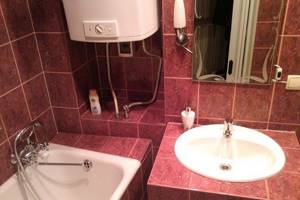
You can obtain permission for boilers with a closed combustion chamber.
Types of water heating columns
Almost all geysers have the same operating principle and appearance. The differences between one or another model may lie in their technical characteristics and design. Currently, all modern speakers can differ in four main ways.
- Throughput (or power) allows you to determine how much water the device heats in a certain period of time. Today on the market you can find models with capacities ranging from 6 to 18 liters. It is not worth purchasing more powerful speakers for the bathroom, since units with a capacity of 18 liters or more are not practical for domestic purposes. For a family of 4 people, a speaker with a capacity of about 12 liters is quite enough.
- The gas burner affects the efficiency of the unit and ease of use. There are three types of burners used in geysers: constant or variable power, and modulating burners. A bathroom column with a constant power burner is capable of independently adjusting the flame depending on how strong the water pressure flows through the device. In columns with variable power burners, it is necessary to adjust the flame manually, but after one-time adjustment, the automation will independently maintain the selected temperature. The most modern - modulating burners allow you to obtain water at a stable temperature at the outlet, regardless of fluctuations and changes at the inlet. The price of modulation burners is slightly higher compared to variable and constant ones, and can range from 9 to 30 thousand rubles.
- Ignition - can be manual (piezo ignition) or electric (battery-powered). More expensive and modern models are equipped with electric ignition, powered by the apartment's electrical network.
- Number of functions - not only the price of the device depends on them, but also reliability and safety, since most additional functions allow you to protect residents from gas leaks and regulate the water pressure in the system and gas in the gas pipeline.
Is it possible to use liquefied gas
Complex bureaucratic procedures are eliminated in cases where liquefied (bottled) gas is used instead of natural gas. But for smooth installation it is necessary to choose the appropriate type of heater.
Burners for 2 types of fuel differ in different sizes of injector nozzles. In addition, equipment for liquefied gas is much less common on sale than for main gas.
The surface of the wall in the bathroom must be made of non-flammable and especially durable materials.
How to install gas equipment in the bathroom
There are several situations in which it is justified to place a gas water heater in the bathroom:
- Replacing the old column.
- Moving equipment from another part of the home.
- Installation of the system from scratch, taking into account the existing project.
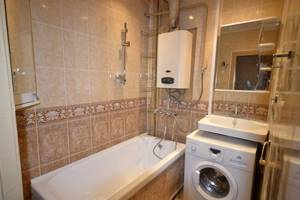
Installation of gas equipment occurs when replacing an old water heater.
Replacement with a new device
The option of replacing the old system with a new one is considered quite simple, but the regulations indicate a direct ban on placing gas-using appliances in the bathroom. To solve the problems, you will have to move the unit to another suitable room, for example, to the kitchen, which is accompanied by a number of problems with connecting the column to the chimney shaft.
Equipment transfer
Transferring the system from the kitchen to the bathroom is considered a more complex undertaking.
In addition to the ban on installing devices in the bathroom, possible problems are explained by the following factors:
- The room dimensions do not meet the installation requirements.
- There is no channel for effective smoke removal in the room.
In addition, before installation, you should obtain official permits and change the apartment gasification project.
Even if the homeowner obtains permission, the costs of bureaucratic issues may exceed the cost of the equipment itself.
If you install a heater without prior approval from the gas service, this can lead to irreparable consequences, including fines or shutdown of the gas supply.
In addition, this option has difficulties from a technical point of view. They are associated with problems when connecting utilities to equipment and securing a heavy unit to the wall.
Features of installation in the proper room
The geyser is the main problem during renovation; you can make the bathroom modern and beautiful by hiding or decorating this equipment. Turn this item into an interesting interior design.
An easy way is to buy a designer speaker model in a certain shade. There are also more sophisticated ones - with patterns and designs. The only and main drawback is, of course, the price, but you simply don’t want to hide such a speaker.

Financial costs play an important role in the choice of repair . If you don’t want to spend money, you can simply decorate the geyser, but major repairs will be significantly expensive.
Another option that will help maintain a unified style is to disguise the speaker in the closet. It will not stand out, it will give the room the necessary comfort and the awkwardness of the unit will no longer irritate you.
Source



